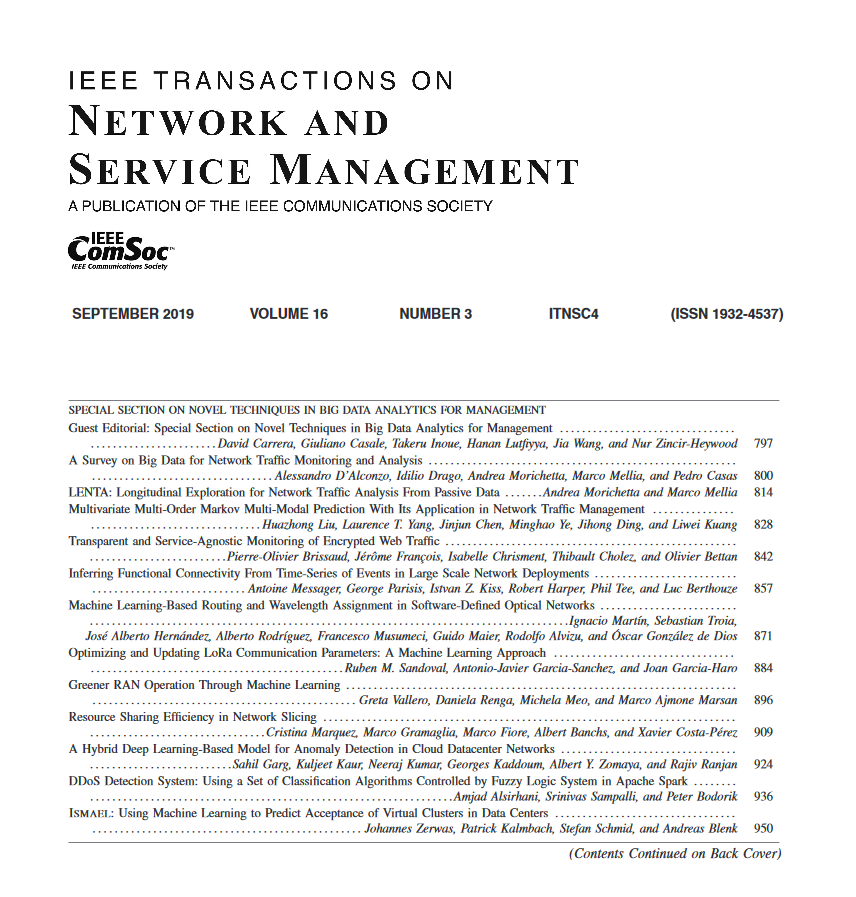保证可接受阻塞概率的多平面扭折闭合网络设计
IF 5.4
2区 计算机科学
Q1 COMPUTER SCIENCE, INFORMATION SYSTEMS
IEEE Transactions on Network and Service Management
Pub Date : 2025-02-07
DOI:10.1109/TNSM.2025.3539907
引用次数: 0
摘要
未来数据中心的发展预计将包括先进的电路交换技术,特别是光交换技术,它可以实现高传输容量和能源效率。先前的研究解决了clos网络设计问题,以保证允许的阻塞概率以最大化交换容量,交换容量由连接到网络的终端数量定义。但是,随着可用的${N} \乘以{N}$交换机数量的增加,由于交换机端口的限制,交换容量不再增加。本文提出了一种多平面的扭曲折叠(TF) Clos网络,命名为MP-TF,通过保证可接受的阻塞概率来提高原TF-Clos网络所限制的交换容量。MP-TF由相同的M个TF-Clos平面和$1\乘以{M}$选择器和${M} \乘以1$选择器组成,每一对选择器都与一个发送器和一个接收器对相关联。我们建立了MP-TF的设计模型,将其作为最大交换容量的优化问题。我们在MP-TF中引入连接允许控制,称为MP-CAC。利用MP-CAC推导出MP-TF设计模型保证允许阻塞概率的定理。数值结果表明,当可用的${N} \次{N}$交换器足够多时,MP-TF增加了TF-Clos平面的交换容量;例如,在请求激活概率为0.6,允许阻塞概率为0.01的情况下,7个平面的交换容量是1个平面的1.97倍。我们发现MP-TF的计算时间随着TF-Clos平面数量的增加而减少。MP-TF的设计类似于单个TF-Clos平面的设计,主要区别在于对连接准入控制的处理。MP-TF具有更大数量的${N} \乘以{N}$开关,可以设计更小的TF-Clos平面。对MP-TF的光功率管理和网络成本进行了分析。本文章由计算机程序翻译,如有差异,请以英文原文为准。
Design of Multiple-Plane Twisted and Folded Clos Network Guaranteeing Admissible Blocking Probability
Future advancements in data centers are anticipated to incorporate advanced circuit switching technologies, especially optical switching, which achieve high transmission capacity and energy efficiency. Previous studies addressed a Clos-network design problem to guarantee an admissible blocking probability to maximize the switching capacity, which is defined by the number of terminals connected to the network. However, as the number of available ${N} \times {N}$ switches increases, the switching capacity no longer increases due to the switch port limitation. This paper proposes a design of a multiple-plane twisted-folded (TF) Clos network, named MP-TF, to enhance the switching capacity, which is limited by the original TF-Clos, by guaranteeing an admissible blocking probability. MP-TF consists of identical M TF-Clos planes and pairs of a $1\times {M}$ selector and an ${M} \times 1$ selector, each pair of which is associated with a transmitter and receiver pair. We formulate a design model of MP-TF as an optimization problem to maximize the switching capacity. We introduce connection admission control in MP-TF, named MP-CAC. We derive the theorem that the MP-TF design model using MP-CAC guarantees the admissible blocking probability. Numerical results observe that MP-TF increases the switching capacity as the number of TF-Clos planes when available ${N} \times {N}$ switches are sufficient; for example, with seven planes, the switching capacity is 1.97 times larger than that of one plane, given a request active probability of 0.6 and an admissible blocking probability of 0.01. We find that the computation time for MP-TF diminishes with an increase in the number of TF-Clos planes. Designing MP-TF is similar to designing a single TF-Clos plane, differing mainly in the handling of connection admission control. With a larger number of ${N} \times {N}$ switches, MP-TF enables the design of a smaller TF-Clos plane. We provide the analyses of optical power management and network cost of MP-TF.
求助全文
通过发布文献求助,成功后即可免费获取论文全文。
去求助
来源期刊

IEEE Transactions on Network and Service Management
Computer Science-Computer Networks and Communications
CiteScore
9.30
自引率
15.10%
发文量
325
期刊介绍:
IEEE Transactions on Network and Service Management will publish (online only) peerreviewed archival quality papers that advance the state-of-the-art and practical applications of network and service management. Theoretical research contributions (presenting new concepts and techniques) and applied contributions (reporting on experiences and experiments with actual systems) will be encouraged. These transactions will focus on the key technical issues related to: Management Models, Architectures and Frameworks; Service Provisioning, Reliability and Quality Assurance; Management Functions; Enabling Technologies; Information and Communication Models; Policies; Applications and Case Studies; Emerging Technologies and Standards.
 求助内容:
求助内容: 应助结果提醒方式:
应助结果提醒方式:


